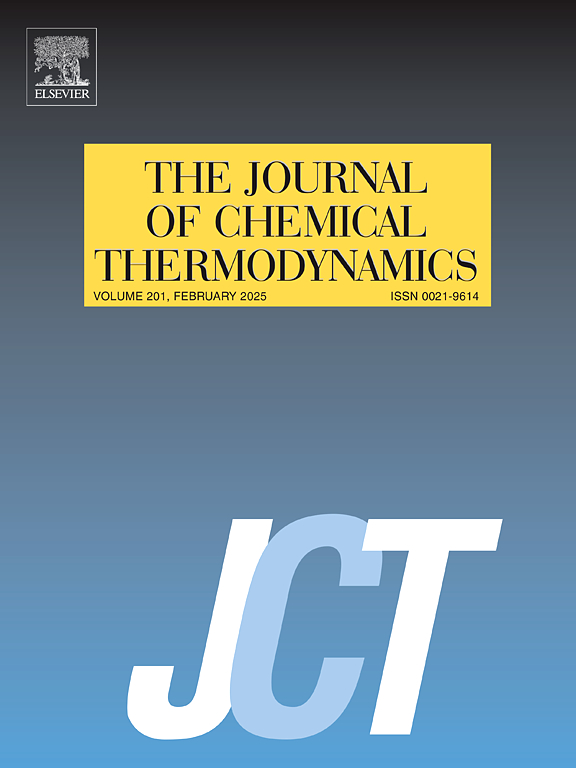Experimental and molecular dynamics study on the thermal conductivity of Octamethyltrisiloxane (MDM)/Decamethyltetrasiloxane (MD2M) mixtures
IF 2.2
3区 工程技术
Q3 CHEMISTRY, PHYSICAL
引用次数: 0
Abstract
Octamethyltrisiloxane (MDM)/Decamethyltetrasiloxane (MD2M) mixtures are considered one of the most suitable working fluids for high temperature Organic Rankine Cycle (ORC) systems and heat pump. As a critical thermophysical property, thermal conductivities of liquid siloxanes are important to understand heat transfer characteristics. In this study, thermal conductivities of MDM/MD2M mixtures (with MDM mass fraction wMDM = 0, 0.30, 0.50, 0.70, 1.00) were measured using a transient hot-wire method over a temperature range of 263.15–343.15 K and pressures up to 8 MPa. Then, an empirical model was proposed to reproduce the thermal conductivity regarding temperature and pressure, yielding an average absolute deviation of less than 1 %. In addition, the thermal conductivities of the MDM/MD2M systems were studied using the non-equilibrium molecular dynamics (NEMD) simulation. The predicted values show good consistency with the experimental results, confirming both the accuracy of the established model and the suitability of the selected force field, while offering a dependable computational method for predicting thermal conductivity. This work provides essential data and theoretical support for evaluating the heat transfer performance and selecting working fluids in MDM/MD2M-based ORC systems.
八甲基三硅氧烷(MDM)/十甲基四硅氧烷(MD2M)混合物导热性的实验及分子动力学研究
八甲基三硅氧烷(MDM)/十甲基四硅氧烷(MD2M)混合物被认为是高温有机朗肯循环(ORC)系统和热泵最适合的工作流体之一。作为一种重要的热物理性质,液态硅氧烷的导热系数对理解其传热特性具有重要意义。在本研究中,使用瞬态热线法测量了MDM/MD2M混合物(MDM质量分数wMDM = 0、0.30、0.50、0.70、1.00)在263.15-343.15 K温度范围和8 MPa压力下的热导率。然后,提出了一个经验模型来再现温度和压力的导热系数,平均绝对偏差小于1%。此外,利用非平衡分子动力学(NEMD)模拟研究了MDM/MD2M体系的热导率。预测值与实验结果吻合较好,证实了所建模型的准确性和所选力场的适用性,为热导率预测提供了可靠的计算方法。该工作为评价基于MDM/ md2m的ORC系统的传热性能和选择工质提供了必要的数据和理论支持。
本文章由计算机程序翻译,如有差异,请以英文原文为准。
求助全文
约1分钟内获得全文
求助全文
来源期刊

Journal of Chemical Thermodynamics
工程技术-热力学
CiteScore
5.60
自引率
15.40%
发文量
199
审稿时长
79 days
期刊介绍:
The Journal of Chemical Thermodynamics exists primarily for dissemination of significant new knowledge in experimental equilibrium thermodynamics and transport properties of chemical systems. The defining attributes of The Journal are the quality and relevance of the papers published.
The Journal publishes work relating to gases, liquids, solids, polymers, mixtures, solutions and interfaces. Studies on systems with variability, such as biological or bio-based materials, gas hydrates, among others, will also be considered provided these are well characterized and reproducible where possible. Experimental methods should be described in sufficient detail to allow critical assessment of the accuracy claimed.
Authors are encouraged to provide physical or chemical interpretations of the results. Articles can contain modelling sections providing representations of data or molecular insights into the properties or transformations studied. Theoretical papers on chemical thermodynamics using molecular theory or modelling are also considered.
The Journal welcomes review articles in the field of chemical thermodynamics but prospective authors should first consult one of the Editors concerning the suitability of the proposed review.
Contributions of a routine nature or reporting on uncharacterised materials are not accepted.
 求助内容:
求助内容: 应助结果提醒方式:
应助结果提醒方式:


